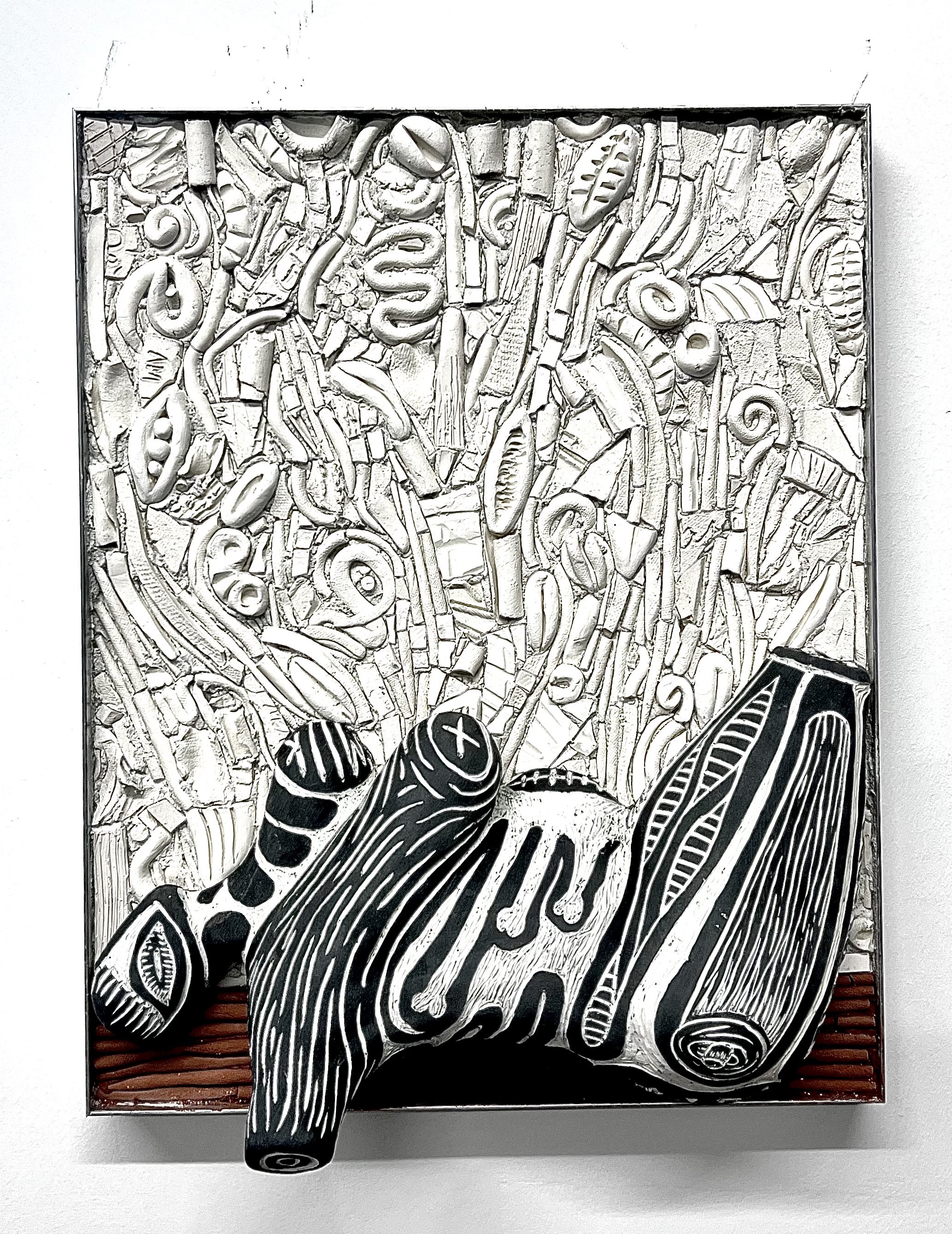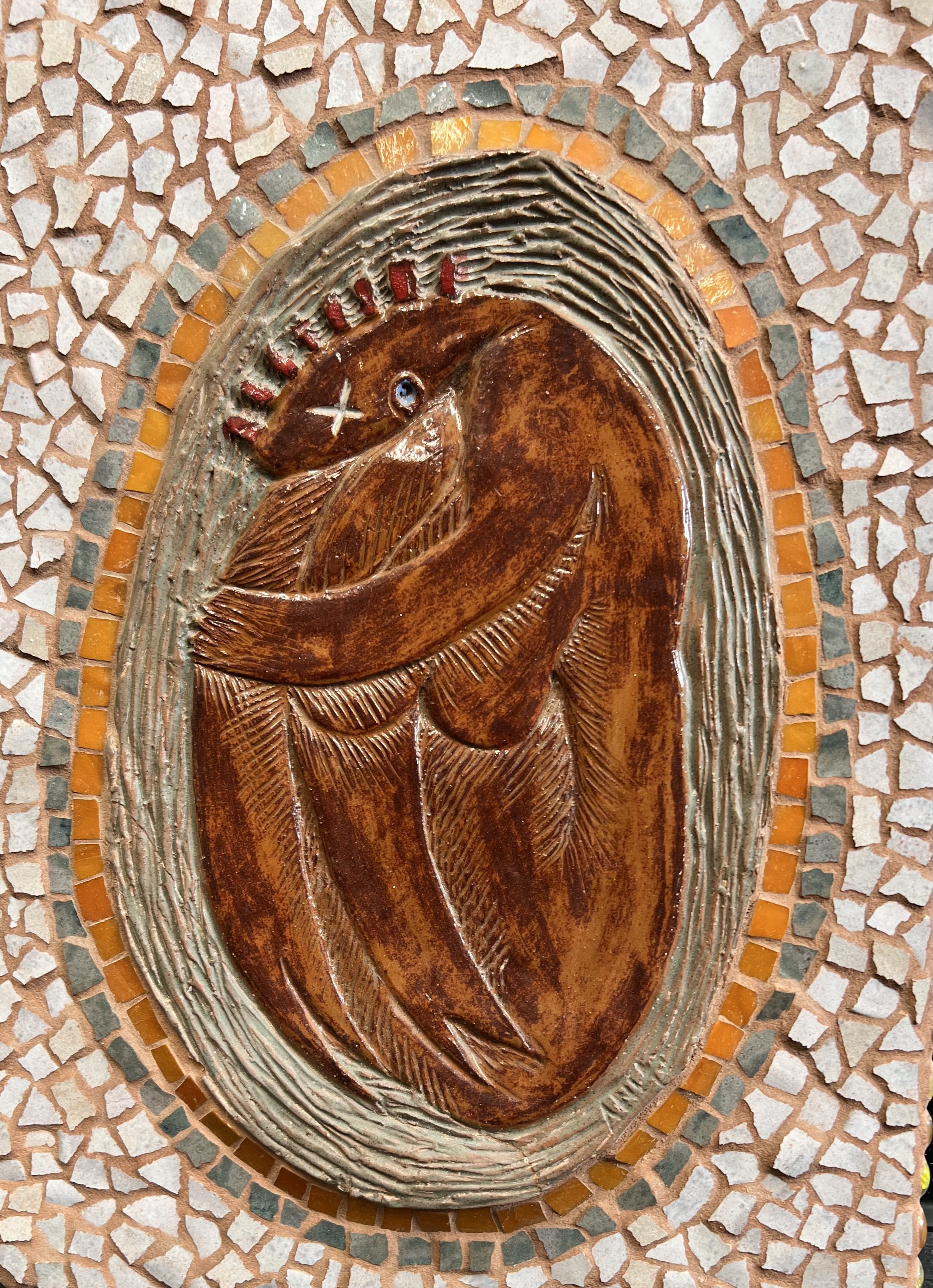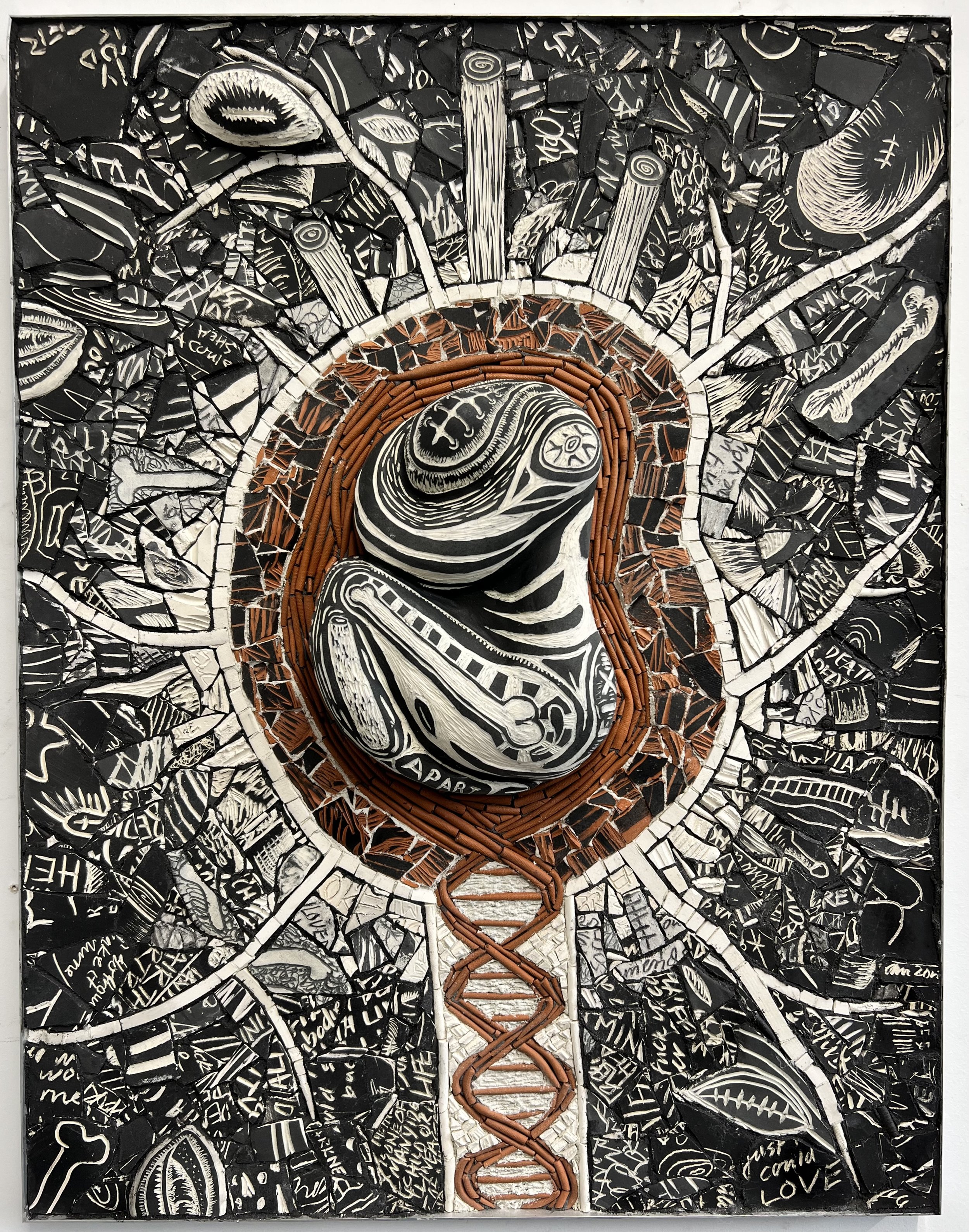Towards Berlin
Mono no aware (物の哀れ),[a] lit. 'the pathos of things', and also translated as 'an empathy toward things', or 'a sensitivity to ephemera', is a Japanese idiom for the awareness of impermanence (無常, mujō), or transience of things, and both a transient gentle sadness (or wistfulness) at their passing as well as a longer, deeper gentle sadness about this state being the reality of life.[2]
I have aspired to live and work in Berlin- specifically to respond to my own deeply personal issues of familial brokenness and repair. My specific multidisciplinary art methodology of mosaic is a means to address dis/connections, dis/associations, and proximity through fragments of broken memory - captured through drawn and inscribed tesserae. My deconstructed images and language both reimagine and pulverize the past to create a new space for repair- enabling acceptance and growth. My practiced based research makes literal and physical connections to contemporary art practices, such as collage and assemblage - processes which may use deconstruction and problem solving to address subjects such as climate change, immigration, inequality, and posttraumatic memory.
I will be participating in the Artists in Residence Program at SomoS Berlin, where I will creating new work and presenting it in a solo exhibition, opening March 26, Kottbusser Damm 95 Berlin Germany. I am completely gobsmacked that also my family and friends are traveling from around the world to join me here in Berlin for the show. The exhibition will travel to ARC Gallery, Chicago, for a September 2024 opening.
I am also leading my workshop, Embracing the Broken, in collaboration with SomoS Arts Berlin and DOMO, the German Organization for Mosaic Artists, February 24-25. For those interested in the workshop at The Chicago Mosaic School, please check the schedule for the all the amazing opportunities there.
REDUX
Emanant, 2023
EXPLORING TIME THROUGH PRACTICE AND PROCESS
Looking at my earlier work around the studio, I am reminded of who I was; it makes me grateful for who I am and who I still may become. The past work is both a touchstone and a point of reference for my survival skills, agility, and tenacity. I approach my works as a series of risk-taking experiments as part of a process of observing while learning and moving towards refinement and an authenticity in my practice.
I returned to an old piece I made in 1991. It was one of my first explorations towards combining a mosaic of disciplines: drawing, carving, clay, sculpture, painting, assemblage, into one art practice. The untitled work, made of whole and broken glazed ceramic shows a center solitary figure- withdrawn and contained, isolated by a protective embryonic-like sac. The figure is surrounded by dead-colored pink flesh shards placed in the background. I never liked or showed this piece. I hid it after I made it -shoved it behind some boards in my studio where it gathered dust and spider webs and existed in the darkness. When I look at this work, just as when I look at most of my work it is a self-portrait, a still life, a snapshot, a still montage of a woman in time. It was 1991 and I was pregnant with my second son, Elias, in a difficult and loveless marriage, still managing to work in my studio with a small child. All the obstacles of money and time and space and a chorus of art naysayers surrounded me, hoping I’d come to my senses and concentrate solely on home and family and give up that art “thing”. I continued my practice, making images that I didn’t completely understand at the time.
In 2019 I moved out of that studio, after 32 years and I excavated a lot of old work that was hidden away in the corners. I kept some for laughs and some for reevaluation. I had buried this work in my studio, just as I had buried those times in my life when I was alone and disconnected and scared and lost. It was then I had been searching for my birthmother for more than 10 years. After the birth of my firstborn, Luke, I had stepped up the search. I was floating untethered in the world; I thought my flesh and blood children would anchor me to the earth, but no. I felt was somebody’s child, I belonged to some tribe somewhere and I came from some mysterious place, but no one could answer these questions, no one could help me or understand the need to know, so I kept searching.
Thirty-two years have passed. I know the answers to those questions. Through, the ‘re-doing’ of this artwork I was forced to revisit that person who was alone without connection. In 1994, I found my birthmother, Gilda, only few years after I made that work. Everything has since shifted- my connection to a disturbing and uncomfortable history and a renewed connection to the mother that raised me, Midge. Perhaps I am too close to the recent work to fully understand it. I am excited by the life in it, the connection and hopefulness I perceive; the pieces and parts of the past and present, collected and composed as articulations of chronology.
Seeing the juxtaposition of these artworks, I experience time, akin to seeing a photograph of a child, knowing that the makings of a person are there but unresolved, incomplete, not at their full potential, still in transition; the story is still unfolding and being told.
The Paralysis of Perfection
The Paralysis of Perfection
©KarenAmi 2023
What is perfect? We may find perfection in nature or symmetry and harmony these ideals can be paralyzing in the creative process. Our life experiences are full of missteps, trials and errors, and mistakes. We move closer to the myth of perfection with knowledge, reflection, and acceptance through the discomfort of growth and transformation. Our own unrealistic expectations for ourselves can prevent us from growing and thriving as creatives. The ability to allow ourselves to make mistakes and play is the key to imaginative productivity. At the core of perfectionism is fear. Fear of failure. Fear of rejection. Fear of not measuring up to other's expectations. Fear of judgement or disapproval of others. This fear can be crippling, especially in the arts which requires us to constantly be producing and putting our whole selves on the line. That vulnerability can stop a perfectionist in their tracks, making it nearly impossible to make anything at all. It is difficult to be creative when you are coming from a place of self-doubt, anxiety and worry about failure.
Perfectionism is a double-edged sword. On one hand, it can motivate you to perform at a high level and deliver top-quality work. On the other hand, it can cause you unnecessary anxiety and slow you down. Perfectionists worry that if they let go of their ‘meticulousness and conscientiousness’ it will hurt performance and standing. That is not to say that skill, technique, and methodology is not an important part of art practice- it is. Yet when we focus more on the structures of the art form ( technique, etc) we may be sacrificing our creativity and art.You are perfectly imperfect. Our ability to adapt and learn and change can help return to a place to play and find joy (again) in art practice.
Redefining Perfectionism in Art Practice:
1. Practice accepting where you are currently with your work. It can be difficult when you first start out (or really at any stage) to accept the gap between where you are and where you want to be. You have a vision for your work, but your skills just aren’t taking you there ... yet.
2. Learn to love your work and yourself regardless of where you want to be. If you are gentle and accepting of your process, you will get there in time.
3. Focus on making more work, more sketches, more models, instead of endlessly picking apart one project.
4. Lower your expectations of yourself and your work .Realize that you don’t have to create a masterpiece every time you enter the studio. If you go in and fingerpaint and it feels good, you learn something, you stretch yourself, and enjoy the process, that is a success. You don’t have to say something huge with every artwork that you make. Take the pressure off and you will enjoy yourself along the way.
5. Since art and creating is a process, you can always change directions, add new ideas, and develop a plan as you go along. Write down all your idea ina notebook, prioritize them if you like. Come to terms with the ones that just aren’t possible due to budget or logistics or physics, or whatever the roadblocks might be that are in the way.
Inside, Out.
Mosaic art is an interdisciplinary art practice that embodies connection, fixing, repair, and reinvention in both process and outcome. I use this practice to understand transient identities through disconnections and brokenness, reattachments and repair. There is value and potential in the broken, the discarded, the obsolete, the destroyed as it is part of nature, of the mutability and ephemerality of life. My visual narratives reflect generational memory and trauma, and the birth politics that have shaped my life.
Throughout my career, I have struggled to make sense of a need to connect to something invisible and unknown; an attempt to decode my fragmented life through my studio practice. I make work by creating, breaking, deconstructing and recomposing clay shards that are inscribed with names, poems, dates and writings as a part of a multi-faceted process of rebuilding and repairing. It is a way to make order out of destruction and chaos, to make sense of my story of origin, to make a connection between broken parts, my mothers and me.
Identity can be a fragmentary composite of experiences, memory and of relationships. I take a feminist, relational approach to art-making that is tactile, integrative and improvisational; it is an articulation of transformation through the consideration of separations, displacements, and reconsidered connections. My studio practice relates to an investigative family journey, displacement, and the historical framing within a post-holocaust community. This process, the art and the writing, is a way I can share knowledge and discover new connections between life and practice.









